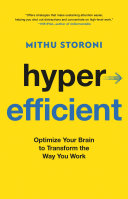

The concept of radical efficiency revolves around the idea of maximizing output while minimizing input. This means not just working harder but working smarter by eliminating waste and focusing on high-impact activities. The book emphasizes the importance of identifying and removing bottlenecks in processes, whether in personal productivity or organizational workflows. By streamlining operations, individuals and organizations can achieve more with less effort, leading to enhanced performance and satisfaction. This idea is grounded in the principles of lean management and agile methodologies, which advocate for continuous improvement and responsiveness to change.
Continue readingIn the age of information, making decisions based on data is crucial for success. Hyperefficient highlights the importance of leveraging analytics and metrics to guide choices rather than relying on intuition alone. The book discusses various tools and techniques for gathering and interpreting data, emphasizing that informed decisions lead to better outcomes. By adopting a data-driven mindset, individuals and organizations can identify trends, measure performance, and make proactive adjustments. This approach not only enhances efficiency but also fosters a culture of accountability and transparency.
Continue readingAutomation is a key theme in Hyperefficient, as it explores how technology can be harnessed to streamline tasks and processes. The book discusses the various forms of automation, from simple task management tools to complex AI-driven systems. It emphasizes the importance of integrating technology seamlessly into existing workflows to enhance productivity. By automating repetitive tasks, individuals can free up time for more strategic activities, leading to greater efficiency. The book also addresses the challenges of technology adoption and offers practical tips for overcoming resistance to change.
Continue readingAn agile mindset is essential for navigating the complexities of modern work environments. Hyperefficient advocates for flexibility, adaptability, and a willingness to iterate. The book draws parallels between agile project management techniques and personal productivity strategies, encouraging readers to embrace change and continuously seek improvement. By fostering an agile mindset, individuals can respond more effectively to shifting priorities and unexpected challenges. This approach not only enhances efficiency but also supports innovation and creativity.
Continue readingCollaboration is a cornerstone of efficiency, and Hyperefficient underscores the importance of effective teamwork. The book explores the dynamics of high-performing teams and provides insights into fostering a collaborative culture. It discusses the roles of communication, trust, and shared goals in driving team success. By prioritizing collaboration, organizations can leverage diverse perspectives and skills, leading to more innovative solutions and improved outcomes. The book also addresses common pitfalls in teamwork and offers strategies for overcoming them.
Continue readingHyperefficient emphasizes the necessity of continuous learning in an ever-evolving landscape. The book advocates for a growth mindset, encouraging readers to seek opportunities for personal and professional development. It highlights the importance of staying current with industry trends, acquiring new skills, and embracing lifelong learning. By investing in development, individuals can enhance their capabilities and adaptability, ultimately contributing to greater efficiency and effectiveness in their roles.
Continue readingThe final key idea in Hyperefficient is the role of mindfulness and focus in achieving efficiency. The book discusses the impact of distractions on productivity and offers strategies for maintaining concentration in a fast-paced world. It emphasizes the importance of setting clear goals and prioritizing tasks to align efforts with desired outcomes. By cultivating mindfulness, individuals can enhance their focus and make more intentional choices, leading to improved efficiency in both personal and professional contexts.
Continue reading